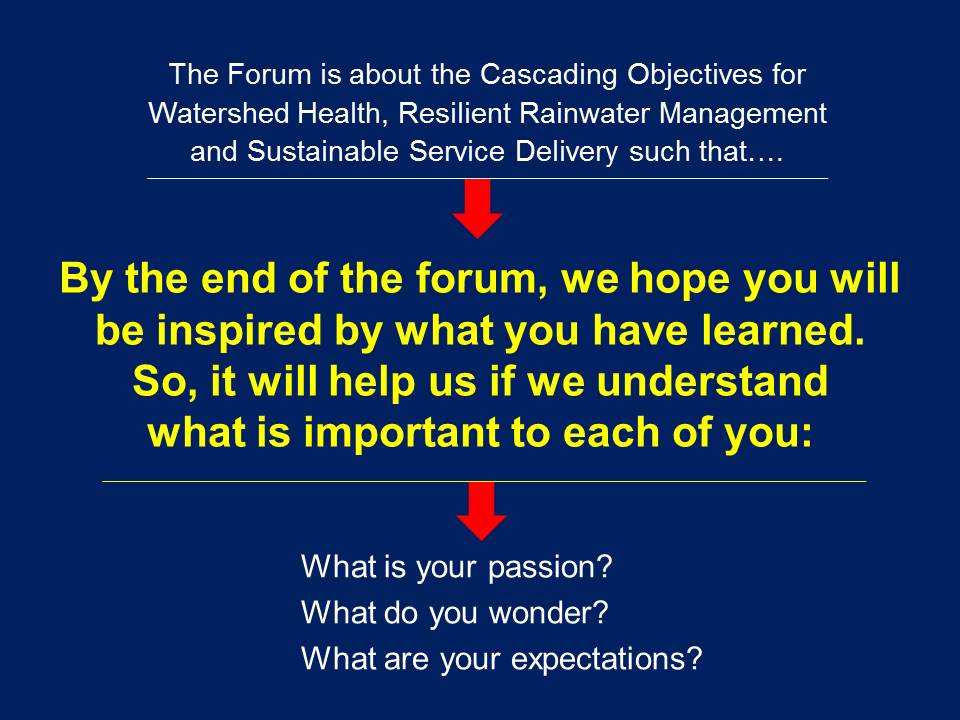2015 Water Balance Forum: “By the end of the forum, we hope you will be inspired by what you have learned,” stated Kim Stephens when kicking off the storytelling segment of the day (YouTube Video)
Note to Reader:
The focus of the opening segment of the Water Balance Forum was on storytelling. The objective in the first half of the segment was to engage and energize the audience. This set the scene for town-hall sharing. Watch the video below.
Why a Water Balance Forum
“Our climate is changing. Think about the drought this past summer. We did dodge a bullet,” stated Kim Stephens in his opening remarks to set the stage for the Water Balance Forum.
 “Think about how critical the situation was – if we had not had a couple of days of rain in late August, there was concern that we were literally that close to running out of water.”
“Think about how critical the situation was – if we had not had a couple of days of rain in late August, there was concern that we were literally that close to running out of water.”
“The reason for mentioning this is that part of the sharing and teaching that we are doing in forums such as this is to challenge you: what will you do differently after you leave today?”
“The actions that each of you take today will ripple through time. So, recognize that as a region and as a province, we dodged a bullet in 2015.”
“Well, then, when we think about the water balance – and the fact we are experiencing wetter, warmer winters and longer, drier summers – that leads us to focus on how the decisions you all make on a daily basis impact on the water balance.”
“This perspective frames the bigger picture. But in terms of the Forum agenda,we are drilling down into the details of the Water Balance Methodology.”
Genesis for the Partnership for Water Sustainability
“In terms of the history of the Partnership, one can say that the genesis was SILG,” continued Kim Stephens when he reviewed the mission of the Partnership.
“Going back 15 years ago, a group of regional champions came together through SILG, This group included Robert Hicks and Ted van der Gulik.”
“The Water Balance Model Partnership was formed by a sub-committee of SILG (in 2002). For most of the following decade, we always had our meetings at the offices of either Metro Vancouver or Environment Canada.”
“To this day, the Partnership has a high level of political support at the Regional Board.”
Watersheds as Infrastructure Assets
“What should you remember today? Keep this in mind – the takeaway for this forum is this phrase: watersheds are infrastructure assets,” emphasized Kim Stephens.
“We have gravitated to this type of language because this is what resonates with Councils.
“We are dealing with an integrated system. And what we really want to stress is that the three Water Balance pathways are actually part of your infrastructure assets. And those pathways provide water balance services.”
Cascading Objectives
“We are talking about cascading objectives,” stated Kim Stephens when speaking to the concluding slide in the opening segment of the Water Balance Forum.
“Think in terms of Watershed Health and how that drops down, first to Resilient Rainwater Management and then to Sustainable Service Delivery.”
“Call it a buzz phrase, if you wish, but Sustainable Service Delivery is now the driver for a lot of things in local government this year.”
“And so, what we hope will be the situation at the end of three hours, is that you will be inspired.”
To Learn More:
Download The Forum is about the Cascading Objectives for Watershed Health, Resilient Rainwater Management and Sustainable Service Delivery (3.9 MB). The presentation comprises the slides inserted below.






